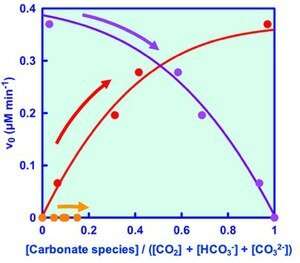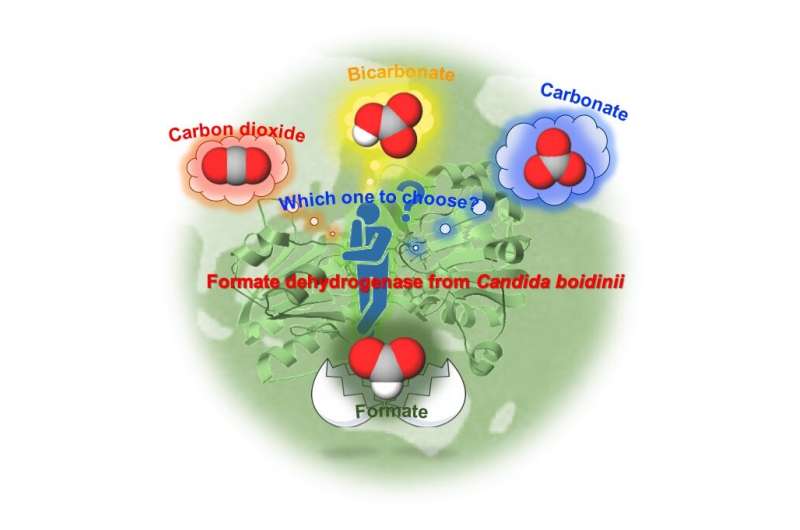Formate dehydrogenase reduces carbon dioxide to formic acid

Professor Yutaka Amao of the Osaka City University Artificial Photosynthesis Research Center and Ryohei Sato, a 1st year Ph.D. student of the Graduate School of Science majoring in Â鶹ÒùÔºics and Chemistry, reveal that the catalyst formate dehydrogenase reduces carbon dioxide directly to formic acid.
The development of an effective catalyst is an important step in creating an artificial photosynthesis system that uses sunlight to convert carbon dioxide into organic molecules. Formate dehydrogenase (FDH) is a catalyst that accelerates the reaction of converting carbon dioxide (CO2) into formic acid (hydrogen energy storage medium etc.) However, until now the details of how this happened were unclear. The research group dissolved FDH in a liquid solution and carbon dioxide was then blown into the solution for the reaction event.
In liquid, carbon dioxide exists in two additional forms other than itself—a biocarbonate ion and a carbonate ion. Until now, it was not known which of these three forms is reduced and converted into formic acid. By changing the amount of each type of carbon dioxide in the liquid solution and controlling them precisely the group found that carbon dioxide itself is directly reduced to formic acid after investigating their reaction with FDH.
The results of this research were published in the New Journal of Chemistry published by the Royal Society of Chemistry (RSC).

With the development of science and technology, it is necessary to prepare for the next generation by promptly solving the serious problems of today, namely global warming due to greenhouse gases, processing of large amounts of industrial waste, and the depletion of fossil energies such as oil and coal. It is essential to build an energy recycling system with a low environmental impact and to develop an energy conversion system that effectively uses greenhouse gases such as carbon dioxide.
CO2 has a reduction target set on a global scale. It is possible to regulate and reduce CO2 emissions, but how to use this as a raw material and convert it into useful substances is also an important issue. These are the circumstances that have drawn attention to artificial photosynthesis technology that uses solar energy to convert carbon dioxide into a usable fuel.
This research group aims to dramatically improve the catalyst 'formate dehydrogenase,' which promotes the reaction of converting carbon dioxide into formic acid—used for fuel, chemical products, and as an energy storage medium. It is known that carbon dioxide exists in a liquid as the biocarbonate ion (HCO3-) and carbonate ion (CO3-) in addition to itself. However, when a reaction in the solution is catalyzed by formate dehydrogenase, it was unclear which of the 3 forms of CO2 was reduced to formic acid.
By changing the amount of these three forms of CO2 in the liquid solution and controlling them with formate dehydrogenase, This study showed that they are reduced to formic acid only when the carbon dioxide ratio is large, as shown in the figure. When the carbon dioxide in the solution was changed to a bicarbonate and carbonate, it was not reduced to formic acid.
We believe that this discovery will guide us in the development and design of catalysts that will help bring about an artificial photosynthesis system that efficiently converts carbon dioxide into organic molecules.
More information: Ryohei Sato et al, Can formate dehydrogenase from Candida boidinii catalytically reduce carbon dioxide, bicarbonate, or carbonate to formate?, New Journal of Chemistry (2020).
Provided by Osaka City University




















